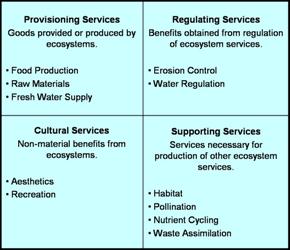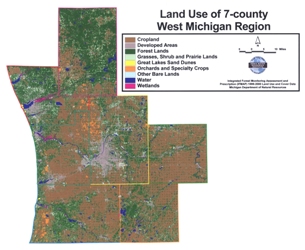INtegrated Valuation of Ecosystem Services Tool (INVEST) - Project Information
Introduction l Project Information l Project Products l Web Tool l Contacts

Green infrastructure is defined as: "An interconnected network of green spaces and other environmental assets that conserves the functions of the natural ecosystem and provides associated benefits to people."[1] In West Michigan, green infrastructure includes dunes, grasslands, forests, wetlands, lakes, rivers and streams, shorelines and riparian habitats, farmland and watersheds.
Ecosystem services are benefits that people obtain, either directly or indirectly, from these ecological systems. Benefits may vary between different systems and include products such as food, fuel, or fiber; services that regulate climate, floods, or water; and nonmaterial assets such as cultural or aesthetic benefits. [2]

We have identified and developed preliminary monetary value estimates of green infrastructure and associated ecosystem services in seven counties in Michigan's lower peninsula: Allegan, Barry, Ionia, Kent, Muskegon, Newaygo and Ottawa counties. These estimates were adapted from previously published economic studies, many of which were conducted in regions outside of Michigan. Because the original data were not unique to the seven-county project region, uncertainties exist in the final value estimates. For many of the land uses and ecosystem services selected, there were no existing economic data to transfer to the region.
The results of this project have been incorporated into the INtegrated Valuation of Ecosystem Services Tool (INVEST), a web-based tool that shows the relative values of the region's land uses and their associated ecosystem services. These relative values represent regional or county-wide averages. Because of our use of average values, as well as other gaps and uncertainties in the data (described in more detail in INVEST), the valuation figures should not be applied to individual parcels.
[1] Benedict, M. and E. McMahon 2002. Green infrastructure: Smart conservation for the 21st Century. The Conservation Fund and Sprawl Watch Clearinghouse: Arlington, VA.
[2] Millennium Ecosystem Assessment 2003. Ecosystems and human well-being: A framework for assessment. Island Press: Washington, D.C.

